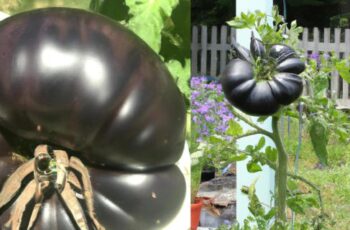Ad Blocker Detected
Our website is made possible by displaying online advertisements to our visitors. Please consider supporting us by disabling your ad blocker.
Surprisingly, summer is one of the best times to divide overgrown hostas. Not only does this practice help rejuvenate excessively large or struggling plants, but it also grants you the opportunity to obtain numerous additional hostas to fill your flowerbeds – all without spending a dime!
While you can certainly dig up and split hostas in the spring or fall, dividing them in the middle of summer offers several advantages. One major benefit is the ease of identifying which plants in your flowerbeds have outgrown their space.
During early spring, it can be challenging to gauge just how large a hosta will become by summer. As the months progress, these plants often grow so vigorously that, by July, they overwhelm the entire flowerbed. Moreover, overly large hosta plants are more susceptible to foliage issues and damage caused by pests during mid-summer.
Delaying the division until fall leaves your flowerbeds in less-than-ideal condition. Furthermore, by autumn, the hosta leaves have already died back, making it difficult once again to accurately assess the plant’s true size. So, take advantage of the summer season to divide your hostas and revitalize your flowerbeds for a stunning and healthy display.
Why Summer Is Great For Dividing Hostas
Dividing hostas during the summer offers distinct advantages, making it a straightforward process to identify which plants need attention. When hostas reach their full size, gardeners can easily spot those that have outgrown their space or spots where additional plants are needed to fill in bare areas.
Furthermore, the summer division is an excellent way to address any hostas showing signs of wear and tear. The best part is that there’s almost no concern about harming your plants; in fact, dividing them in the summer can be beneficial!
While many perennials cannot be dug up, split, and transplanted during the hot summer months, hostas defy that rule. Their incredible durability and hardiness make them nearly indestructible. Hosta roots grow in clumps called rhizomes, which are incredibly robust and resilient. Even when split in the midst of the summer heat, the rhizomes quickly re-establish themselves in the soil with minimal risk of injury.
The beauty of dividing in the summer lies in the fact that the rhizomes have ample time to develop new foliage before the fall season arrives. What’s more, this summer rejuvenation sets them up for exceptional growth in the following spring and summer. So, take advantage of the hostas’ resilience and divide them in the summer for healthy, vibrant plants that will thrive throughout the seasons.
How To Divide Overgrown Hostas In Summer
Dividing hosta plants in the middle of summer is surprisingly easy, requiring just a shovel and a good pair of hedge shears or clippers, and you’re all set to begin.
During summer division, it’s essential to understand that you won’t be able to save the existing leaves of the plant. The process of digging up, dividing, and transplanting is quite stressful for the plant, making it impossible for it to retain its foliage.
However, there’s good news! New foliage will quickly emerge, especially if the plants receive adequate water. This can be beneficial for plants that were previously looking lackluster. Not only can you trim down overly large plants, but they will regrow fresh leaves and start anew.
When dealing with overgrown hostas, it’s best to start by cutting back all of the foliage. Removing the leaf canopy makes it easier to see the root structure and simplifies the process of splitting the root ball into sections.
A pair of hedge shears will make quick work of this task. Cut the hosta back to about one to two inches above the ground. Leaving an inch or two of stems will help you locate the plants after replanting. This way, it becomes easier to water them correctly later on without confusion.
Digging Up The Plant
To begin dividing the hosta plant, start by digging around its entire perimeter. Utilize the remaining foliage stems as a guide, digging a few inches behind the edge of the stems. Once you’ve completed digging around the entire perimeter, go deeper with the shovel and attempt to lift the plant out of the ground.
In most cases, the plant will come out quite easily using this method. However, if the hosta is particularly old and large, you may need to remove it in sections. After the entire root ball or sections are out of the ground, turn the plant over to get a better view of the roots, making it easier to cut equal transplant sections.
To divide the plant into new sections, use a garden knife (hori-hori) or a sharp shovel. Alternatively, for exceptionally large root balls, a sharp axe can be an effective tool. It cuts the roots swiftly, cleanly, and with minimal effort.
Don’t worry about damaging the roots during the cutting process. As mentioned earlier, hosta plants are incredibly tough and resilient. As long as you ensure that each division has a few inches of roots, they will easily regrow and establish themselves successfully.
Creating Transplants
Ensure you leave at least two square inches for each new plant you wish to create while dividing your hostas. For hostas with a projected twelve-inch canopy, aim for two to three-inch cuttings. If you want hostas with a larger canopy range of two to three feet, opt for four to six-inch root sections.
While it’s possible to create larger divisions for bigger plants, keep in mind that they will require more frequent division to remain manageable. So, strike a balance between the size of divisions and the ease of maintenance to ensure your hostas thrive and stay in good shape.
Transplanting
When transplanting in the summer, the key to success is getting the plants in the ground quickly. It is always best to transplant the same day you dig up and divide your hostas. This keeps the moisture in the plant and will speed up the recovery time for new foliage.
If you simply can’t replant the same day, keep transplants in a cool, dark location and water them. They can survive for weeks, but again, they will recover much faster with speedy replanting.
Dig new planting holes a few inches wider and one inch deeper than the existing root section. Fill the bottom of your planting hole with an equal mix of soil and compost. Set the root section in the hole so the surface of the plant is equal to the surrounding soil.
Fill in around the roots with more of the compost and soil mix and water well to set the roots. The compost and soil combination will help roots to re-establish quickly and feed them at the same time. Continue to water every few days until new foliage begins to appear.

